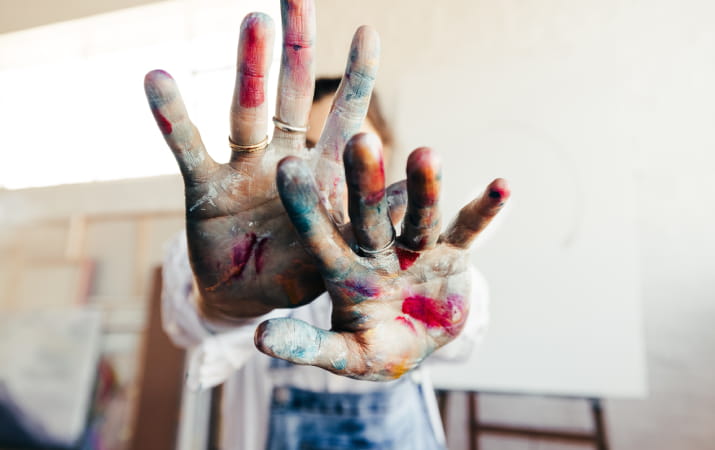Is it possible to make a career in the arts?
Artist and arts entrepreneur James Voller reflects on how he made it in this competitive and creative sector, and gives advice on how you can too.

Between a meeting with his bookkeeper, an appointment with a local council to talk about closing off a footpath, and a catch-up with an engineer to discuss the finer details of sculpture bases, photographic artist James Voller’s afternoon is not what you would call glamorous.
But this ‘day in the life’ of the New Zealand-born, Melbourne-based founder and director of Collide Public Arts is representative of how broad the spectrum of ‘normal’ is for those who work in the arts. “I’m super lucky that I get to do this,” he says. “It’s not in its most pure form, I guess, it's a lot of compromise as well. [But] I get to live off my art.”
When you think of establishing a career in the arts, you might envisage evenings spent among like-minded peers at gallery openings, or weekends holed up in a converted warehouse studio space, just you, your canvas, and a paint palette. And for some career artists that may well be the case.
But becoming aware of all the possibilities—from the vast number of different arts courses and art forms to the diversity of jobs available today—will help you to make pragmatic decisions about how to approach a career in this exciting and creative field.
Can I make a career out of art?
In short, yes, absolutely; so long as it’s your passion, says James. “When you're younger, or just getting into the arts, if you don't have that passion you won't explore [the discipline] as much, or have as much fun experimenting. You've gotta be passionate,” he says.
It’s true that passion and drive arguably underlie success in almost any job, whatever the industry. But in the field of art, where positions are highly sought-after, passion is a pivotal element because of how it motivates you to get ahead. “It's always been competitive and it always will be,” James explains. “That's the nature of the beast.”
| Related reading: Should I study what I love or what's practical? |
Beyond passion, James says the ability to be flexible, open-minded, and unafraid of making mistakes is key to carving out a career in the arts. “I started a business a few years ago with some friends,” he says. “We just tried to aim a little bit too big too soon. Being a little less single-minded might have been good. Having the ability to pivot and to look at others [and what they’re doing] is important.”
On the plus side, James explains that sometimes those early career blunders are actually important building blocks for your future. “When you’ve made a mistake you’re not so afraid of failing the next time,” he notes.
What art careers are in demand?
The array of arts careers available today is vast. But as a starting point, arts graduates can go on to become curators, photographers, graphic designers, interior designers, web designers, professional artists, art teachers, arts administrators or art gallery directors.
As an ever-evolving field, the jobs landscape today looks wildly different to even a decade ago. Niches in areas such as mural art have, for example, transformed from an underground movement in the 80s to a mainstream art practice today, enabling a small but growing number of Australian artists to make a living from private and public commissions. Meanwhile other art forms such as multimedia art, 3D printing and digital art, including NFTs, are still in their infancy.
Some of the art and creative design jobs most in demand today are in interior design (projected growth of 19.1%), web design, illustration and graphic design (projected collective growth of 21.7%). And looking ahead, the National Skills Commission predicts future national demand to be ‘strong’ in the fields of arts administration/management, painting (visual arts), pottery/ceramics, and community arts work.

How hard is it to get a job in art?
While the arts has always been a competitive industry, things are definitely changing, says James. “It was a bit more of an old boys club,” he says of when he started out. “[But] there's a range of new opportunities for different voices today—that's something that gives me hope.”
And while COVID-19 sidelined the industry, the future is looking a little rosier for those working in the field. In early 2023, the Albanese government committed to $286 million in new funding for the arts sector as part of its ‘Revive’ policy.
And yet, despite these advances, it’s true that a career in the arts still represents a niche. According to the Australian Government’s labour market insights there are just 7,200 visual arts and crafts professionals employed in Australia, and only around 49% of those people work full-time hours, in all their jobs combined.
Ultimately, the difficulty of getting a job in the arts hinges on your expectations, your goals, how flexible you’re willing to be, and what trade-offs you’re willing to make. Establishing yourself as an independent artist, for example, takes time. And even then there are no guarantees that it will offer a sustainable income long-term.
“One of the hard truths is the financial side of the arts,” notes James. “I've got two or three mates that are talented enough that they can make a career out of it.”
Other friends of his have found a happy medium with more stable salaried jobs in the field.
I know people that are technicians, art handlers, doing curatorships, or assisting artists that are really happy. Usually these roles are quite flexible and [another benefit is that] you’re keeping in touch with the art world as well.”
While working in the field as a technician might not be your end goal, it can prove a useful introduction to the industry and networking opportunity, notes James: “If you’re working with top-notch gallerists that can help push your career as well. Stay true to what you really want to do and new doors will open up for you.”
For some young emerging artists, balancing a day job with art as a side hustle can prove a more satisfying mix. In the early days of his career, James worked in visitor services at Melbourne’s ACMI in between freelance jobs at festivals, arts residencies in Austria and the USA, and exhibitions in London and Christchurch. It allowed him to exploit exciting creative opportunities while still earning a wage.
“The 9-5 can be quite hard to create around,” he explains. “But [those] other avenues of work do give you more flexibility. And those things that you’ve learnt outside of the arts are so crucial: it’s helped to inform my art practice now.”

Why study fine arts?
Studying fine arts can equip you with the necessary skills to succeed in the ‘real world’. You’ll learn how to evaluate and synthesise information, how to work both independently and collaboratively, and how to problem solve. Research conducted in 2009-10 by the Australia Council for the Arts showed that a lack of business skills proved a common stumbling block for freelance artists.
Moreover, university can be a great place to explore and hone your craft.
At uni it’s a safe space to experiment and try some new things,” says James. “You’ve got excellent resources.”
James has three degrees, all in the field of fine art. He calls each a “stepping stone” in terms of career advancement, offering him the opportunity to refine his skills.
As is the case with most courses in fine art, James’s bachelor degree offered a grounding in a variety of visual arts, multimedia and design subjects before allowing specialisation: a process that has been scientifically proven to have merit. A study released in 2021 showed that the secret to a career-defining ‘creative hot streak’ involved experimenting with a wide range of subjects, styles, and techniques before perfecting a specific area of one’s craft.
“I really wanted to do photography,” James explains. “So when one of my tutors told me I was good at sculpture—I was quite horrified at that.”
But this early experimentation, and his receptiveness to it, shaped the direction of James’s career. “It’s really important today to follow your own path and stay true to your concepts but at the same time look for gaps in the market,” he says.
His business Collide—a public art initiative at the intersection of art and architecture, which helps artists to create large-scale permanent and temporary works—is a true example of that philosophy. “I could see an opening between sculpture and photography,” he explains. “A gap between artists and developers. [It] reflected a need in the market.”
Start your journey in the arts with an art and design course. Discover what’s available online with leading universities through Open Universities Australia.



